Effects of Bio-Based Polyelectrolyte Complex on Thermal Stability, Flammability, and Mechanical Properties Performance Utilization in PLA/PBS Composites
Abstract
1. Introduction
2. Materials and Methods
2.1. Materials
2.2. Sample Preparation
2.2.1. Synthesis of PA-PEI
2.2.2. Synthesis of PA-Arg
2.2.3. Preparation of the Flame Retardant P/15B Based Biocomposites
2.3. Characterization
2.3.1. Fourier-Transform Infrared Analysis (FTIR)
2.3.2. X-ray Diffraction (XRD)
2.3.3. Scanning Electron Microscopy (SEM)
2.3.4. Thermogravimetric Analysis (TGA)
2.3.5. Mechanical Test
2.3.6. UL-94 Vertical Burning Test
2.3.7. Cone Calorimeter Test (CCT)
3. Result and Discussions
3.1. Characterization of PA-PEI and PA-Arg
3.2. Thermal Analysis of P/15B Biocomposites
3.3. Surface Analysis of P/15B Biocomposites
3.4. Mechanical Analysis of P/15B Biocomposites
3.5. Flame Retardancy Properties of P/15B Biocomposites
4. Conclusions
Author Contributions
Funding
Data Availability Statement
Conflicts of Interest
References
- United Nations, World Urbanization Prospects: The 2018 Revision. Available online: https://www.un.org/development/desa/pd/content/world-urbanization-prospects-2018-revision (accessed on 30 June 2022).
- Dadsetan, S.; Siad, H.; Lachemi, M.; Sahmaran, M. Construction and demolition waste in geopolymer concrete technology: A review. Mag. Concr. Res. 2019, 71, 1232–1252. [Google Scholar] [CrossRef]
- Pozo Morales, A.; Güemes, A.; Fernandez-Lopez, A.; Carcelen Valero, V.; De La Rosa Llano, S. Bamboo–Polylactic Acid (PLA) Composite Material for Structural Applications. Materials 2017, 10, 1286. [Google Scholar] [CrossRef] [PubMed]
- Bourbigot, S.; Fontaine, G. Flame retardancy of polylactide: An overview. Polym. Chem. 2010, 1, 1413–1422. [Google Scholar] [CrossRef]
- Ilyas, R.A.; Sapuan, S.M.; Harussani, M.M.; Hakimi, M.Y.A.Y.; Haziq, M.Z.M.; Atikah, M.S.N.; Asyraf, M.R.M.; Ishak, M.R.; Razman, M.R.; Nurazzi, N.M.; et al. Polylactic Acid (PLA) Biocomposite: Processing, Additive Manufacturing and Advanced Applications. Polymers 2021, 13, 1326. [Google Scholar] [CrossRef]
- Wang, L.; Ma, W.; Gross, R.A.; McCarthy, S.P. Reactive compatibilization of biodegradable blends of poly(lactic acid) and poly(ε-caprolactone). Polym. Degrad. Stab. 1998, 59, 161–168. [Google Scholar] [CrossRef]
- Sheth, M.; Kumar, R.A.; Davé, V.; Gross, R.A.; McCarthy, S.P. Biodegradable polymer blends of poly(lactic acid) and poly(ethylene glycol). J. Appl. Polym. Sci. 1997, 66, 1495–1505. [Google Scholar] [CrossRef]
- Chen, G.X.; Kim, H.S.; Kim, E.S.; Yoon, J.S. Compatibilization-like effect of reactive organoclay on the poly(l-lactide)/poly(butylene succinate) blends. Polymer 2005, 46, 11829–11836. [Google Scholar] [CrossRef]
- Chiu, H.T.; Huang, S.Y.; Chen, Y.F.; Kuo, M.T.; Chiang, T.Y.; Chang, C.Y.; Wang, Y.H. Heat Treatment Effects on the Mechanical Properties and Morphologies of Poly (Lactic Acid)/Poly (Butylene Adipate-co-terephthalate) Blends. Int. J. Polym. Sci. 2013, 2013, 951696. [Google Scholar] [CrossRef]
- Yokohara, T.; Yamaguchi, M. Structure and properties for biomass-based polyester blends of PLA and PBS. Eur. Polym. J. 2008, 44, 677–685. [Google Scholar] [CrossRef]
- Gigli, M.; Fabbri, M.; Lotti, N.; Gamberini, R.; Rimini, B.; Munari, A. Poly(butylene succinate)-based polyesters for biomedical applications: A review. Eur. Polym. J. 2016, 75, 431–460. [Google Scholar] [CrossRef]
- Van de Velde, K.; Kiekens, P. Biopolymers: Overview of several properties and consequences on their applications. Polym. Test. 2002, 21, 433–442. [Google Scholar] [CrossRef]
- Naser, A.Z.; Deiab, I.; Darras, B.M. Poly(lactic acid) (PLA) and polyhydroxyalkanoates (PHAs), green alternatives to petroleum-based plastics: A review. RSC Adv. 2021, 11, 17151–17196. [Google Scholar] [CrossRef]
- Wang, D.Y.; Song, Y.P.; Lin, L.; Wang, X.L.; Wang, Y.Z. A novel phosphorus-containing poly(lactic acid) toward its flame retardation. Polymer 2011, 52, 233–238. [Google Scholar] [CrossRef]
- Pattanashetti, N.A.; Heggannavar, G.B.; Kariduraganavar, M.Y. Smart Biopolymers and their Biomedical Applications. Procedia Manuf. 2017, 12, 263–279. [Google Scholar] [CrossRef]
- Xiao, F.; Fontaine, G.; Bourbigot, S. Recent developments in fire retardancy of polybutylene succinate. Polym. Degrad. Stab. 2021, 183, 109466. [Google Scholar] [CrossRef]
- Tawiah, B.; Yu, B.; Fei, B. Advances in Flame Retardant Poly(Lactic Acid). Polymers 2018, 10, 876. [Google Scholar] [CrossRef]
- Venier, M.; Salamova, A.; Hites, R.A. Halogenated Flame Retardants in the Great Lakes Environment. Acc. Chem. Res. 2015, 48, 1853–1861. [Google Scholar] [CrossRef]
- Jans, U. Emerging Brominated Flame Retardants in Sediments and Soils: A Review. Curr. Pollut. Rep. 2016, 2, 213–223. [Google Scholar] [CrossRef]
- Charbonnet, J.A.; Weber, R.; Blum, A. Flammability standards for furniture, building insulation and electronics: Benefit and risk. Emerg. Contam. 2020, 6, 432–441. [Google Scholar] [CrossRef]
- Zhang, T.; Yan, H.; Shen, L.; Fang, Z.; Zhang, X.; Wang, J.; Zhang, B. A phosphorus-, nitrogen- and carbon-containing polyelectrolyte complex: Preparation, characterization and its flame retardant performance on polypropylene. RSC Adv. 2014, 4, 48285–48292. [Google Scholar] [CrossRef]
- Shih, Y.; Chen, Y.; Lai, S.; Chen, Y.; Wang, S.; Zhang, S.P. The effect of thermal, flammability, and mechanical properties of wood plastic composites made from recycled food-packaging LDPE and eco-friendly phytic acid. Int. J. Appl. Eng. Res. 2021, 18, 2021266. [Google Scholar] [CrossRef]
- Kabir, I.I.; Sorrell, C.C.; Mofarah, S.S.; Yang, W.; Yuen, A.C.Y.; Nazir, M.T.; Yeoh, G.H. Alginate/Polymer-Based Materials for Fire Retardancy: Synthesis, Structure, Properties, and Applications. Polym. Rev. 2021, 61, 357–414. [Google Scholar] [CrossRef]
- Hobbs, C.E. Recent Advances in Bio-Based Flame Retardant Additives for Synthetic Polymeric Materials. Polymers 2019, 11, 224. [Google Scholar] [CrossRef] [PubMed]
- Laoutid, F.; Vahabi, H.; Shabanian, M.; Aryanasab, F.; Zarrintaj, P.; Saeb, M.R. A new direction in design of bio-based flame retardants for poly(lactic acid). Fire Mater. 2018, 42, 914–924. [Google Scholar] [CrossRef]
- Hörold, S. Chapter 6—Phosphorus-based and Intumescent Flame Retardants. In Polymer Green Flame Retardants; Papaspyrides, C.D., Kiliaris, P., Eds.; Elsevier: Amsterdam, The Netherlands, 2014; pp. 221–254. [Google Scholar] [CrossRef]
- Mishra, N.; Vasava, D. Recent developments in s-triazine holding phosphorus and nitrogen flame-retardant materials. J. Fire Sci. 2020, 38, 552–573. [Google Scholar] [CrossRef]
- Hamdani, S.; Longuet, C.; Perrin, D.; Lopez-cuesta, J.-M.; Ganachaud, F. Flame retardancy of silicone-based materials. Polym. Degrad. Stab. 2009, 94, 465–495. [Google Scholar] [CrossRef]
- Perera, I.; Seneweera, S.; Hirotsu, N. Manipulating the Phytic Acid Content of Rice Grain Toward Improving Micronutrient Bioavailability. Rice 2018, 11, 4. [Google Scholar] [CrossRef]
- Ye, G.; Huo, S.; Wang, C.; Shi, Q.; Liu, Z.; Wang, H. One-step and green synthesis of a bio-based high-efficiency flame retardant for poly (lactic acid). Polym. Degrad. Stab. 2021, 192, 109696. [Google Scholar] [CrossRef]
- Wu, F.; Xu, J.; Qiu, X.; Lin, S.; Zhang, M.; Ma, M.; Shi, Y.; He, H.; Chen, S.; Wang, X. Super-Low-Addition Biobased Flame Retardant Dedicated to Polylactic Acid through Ionic Reaction between Phytic Acid and Taurine. ACS Appl. Polym. Mater. 2021, 3, 4579–4586. [Google Scholar] [CrossRef]
- Costes, L.; Laoutid, F.; Brohez, S.; Delvosalle, C.; Dubois, P. Phytic acid–lignin combination: A simple and efficient route for enhancing thermal and flame retardant properties of polylactide. Eur. Polym. J. 2017, 94, 270–285. [Google Scholar] [CrossRef]
- Liu, L.; Huang, Z.; Pan, Y.; Wang, X.; Song, L.; Hu, Y. Finishing of cotton fabrics by multi-layered coatings to improve their flame retardancy and water repellency. Cellulose 2018, 25, 4791–4803. [Google Scholar] [CrossRef]
- Dong, H.; Ding, L.; Yan, F.; Ji, H.; Ju, H. The use of polyethylenimine-grafted graphene nanoribbon for cellular delivery of locked nucleic acid modified molecular beacon for recognition of microRNA. Biomaterials 2011, 32, 3875–3882. [Google Scholar] [CrossRef]
- Zhu, Z.M.; Shang, K.; Wang, L.X.; Wang, J.S. Synthesis of an effective bio-based flame-retardant curing agent and its application in epoxy resin: Curing behavior, thermal stability and flame retardancy. Polym. Degrad. Stab. 2019, 167, 179–188. [Google Scholar] [CrossRef]
- Gao, Y.Y.; Deng, C.; Du, Y.Y.; Huang, S.C.; Wang, Y.Z. A novel bio-based flame retardant for polypropylene from phytic acid. Polym. Degrad. Stab. 2019, 161, 298–308. [Google Scholar] [CrossRef]
- Huo, S.; Yang, S.; Wang, J.; Cheng, J.; Zhang, Q.; Hu, Y.; Ding, G.; Zhang, Q.; Song, P. A liquid phosphorus-containing imidazole derivative as flame-retardant curing agent for epoxy resin with enhanced thermal latency, mechanical, and flame-retardant performances. J. Hazard. Mater. 2020, 386, 121984. [Google Scholar] [CrossRef]
- Liang, B.; Hong, X.; Zhu, M.; Gao, C.; Wang, C.; Tsubaki, N. Synthesis of novel intumescent flame retardant containing phosphorus, nitrogen and boron and its application in polyethylene. Polym. Bull. 2015, 72, 2967–2978. [Google Scholar] [CrossRef]
- Yang, Y.X.; Haurie, L.; Zhang, J.; Zhang, X.Q.; Wang, R.; Wang, D.Y. Effect of bio-based phytate (PA-THAM) on the flame retardant and mechanical properties of polylactide (PLA). Express Polym. Lett. 2020, 14, 705–716. [Google Scholar] [CrossRef]
- Park, J.W.; Im, S.S. Phase behavior and morphology in blends of poly(L-lactic acid) and poly(butylene succinate). J. Appl. Polym. Sci. 2002, 86, 647–655. [Google Scholar] [CrossRef]
- Chaiwutthinan, P.; Pimpan, V.; Chuayjuljit, S.; Leejarkpai, T. Biodegradable Plastics Prepared from Poly(lactic acid), Poly(butylene succinate) and Microcrystalline Cellulose Extracted from Waste-Cotton Fabric with a Chain Extender. J. Polym. Environ. 2015, 23, 114–125. [Google Scholar] [CrossRef]
- Rasheed, M.; Jawaid, M.; Parveez, B.; Hussain Bhat, A.; Alamery, S. Morphology, Structural, Thermal, and Tensile Properties of Bamboo Microcrystalline Cellulose/Poly(Lactic Acid)/Poly(Butylene Succinate) Composites. Polymers 2021, 13, 465. [Google Scholar] [CrossRef]
- Zhang, Y.; Jing, J.; Liu, T.; Xi, L.; Sai, T.; Ran, S.; Fang, Z.; Huo, S.; Song, P. A molecularly engineered bioderived polyphosphate for enhanced flame retardant, UV-blocking and mechanical properties of poly(lactic acid). Chem. Eng. J. 2021, 411, 128493. [Google Scholar] [CrossRef]
- Liao, F.; Ju, Y.; Dai, X.; Cao, Y.; Li, J.; Wang, X. A novel efficient polymeric flame retardant for poly (lactic acid) (PLA): Synthesis and its effects on flame retardancy and crystallization of PLA. Polym. Degrad. Stab. 2015, 120, 251–261. [Google Scholar] [CrossRef]
- Jin, X.; Gu, X.; Chen, C.; Tang, W.; Li, H.; Liu, X.; Bourbigot, S.; Zhang, Z.; Sun, J.; Zhang, S. The fire performance of polylactic acid containing a novel intumescent flame retardant and intercalated layered double hydroxides. J. Mater. Sci. 2017, 52, 12235–12250. [Google Scholar] [CrossRef]
- Sun, L.; Xie, Y.; Wu, J.; Wang, H.; Wang, S.; Li, W.; Zhang, J.; Zhang, Z.; Zhu, P.; Lu, Z.; et al. A novel P/N-based flame retardant synthesized by one-step method toward cotton materials and its flame-retardant mechanism. Cellulose 2021, 28, 3249–3264. [Google Scholar] [CrossRef]
- Chen, Y.; Xu, L.; Wu, X.; Xu, B. The influence of nano ZnO coated by phosphazene/triazine bi-group molecular on the flame retardant property and mechanical property of intumescent flame retardant poly (lactic acid) composites. Thermochim. Acta 2019, 679, 178336. [Google Scholar] [CrossRef]
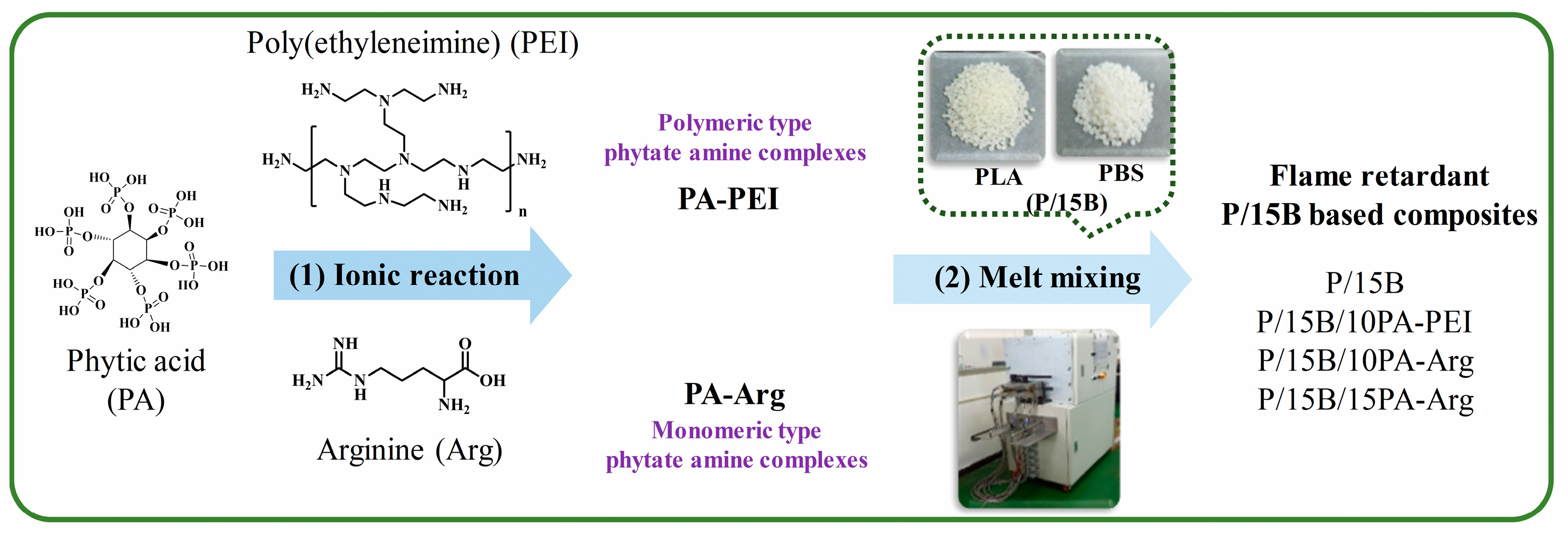

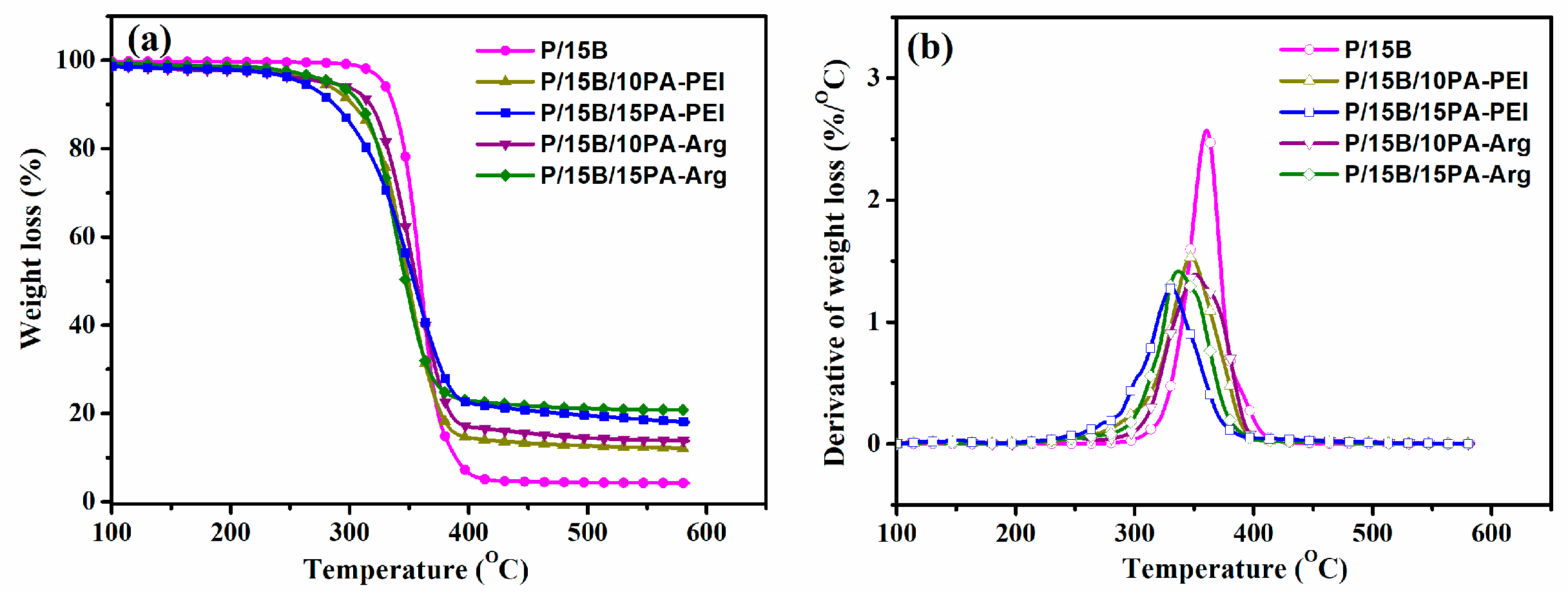
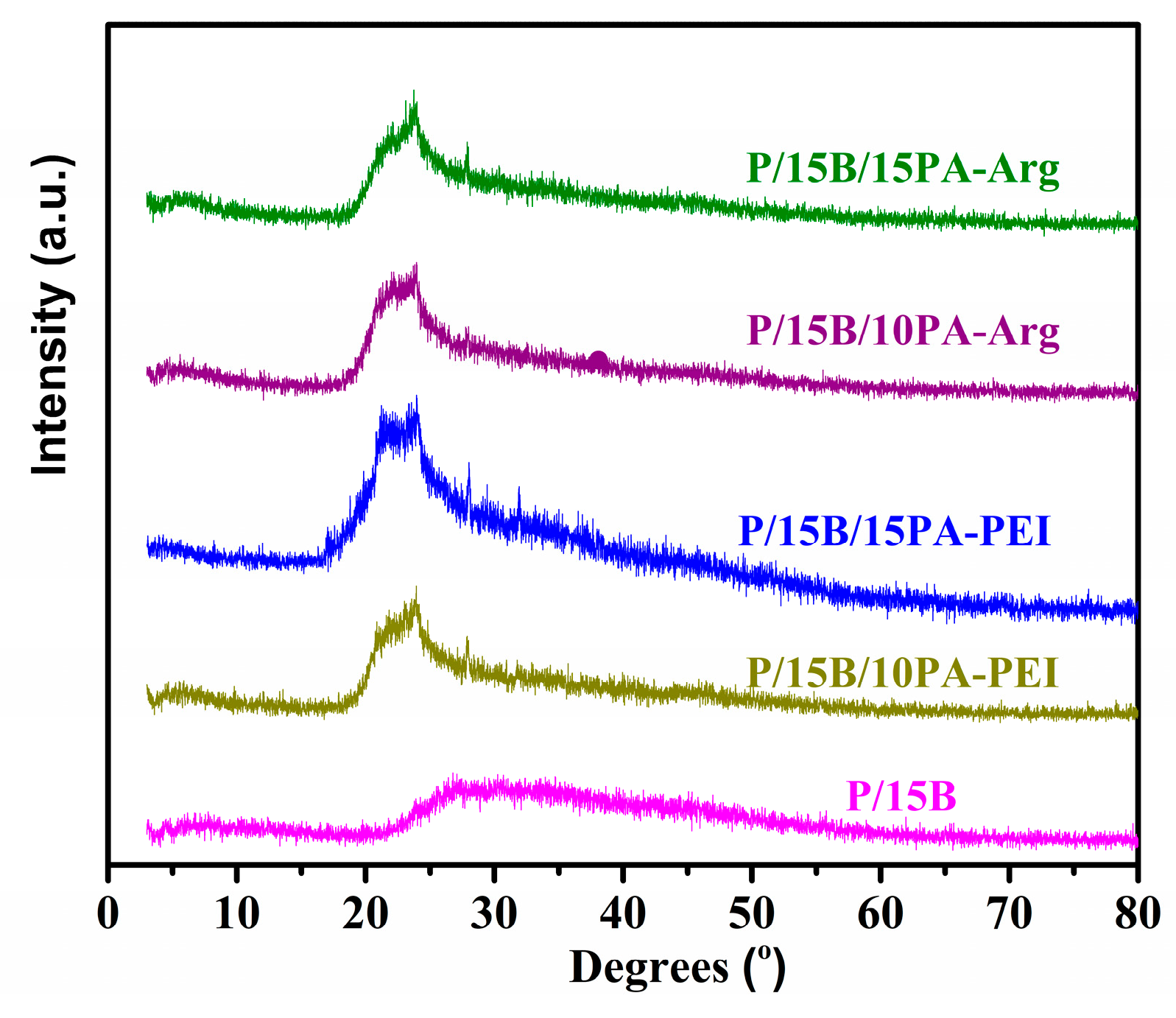


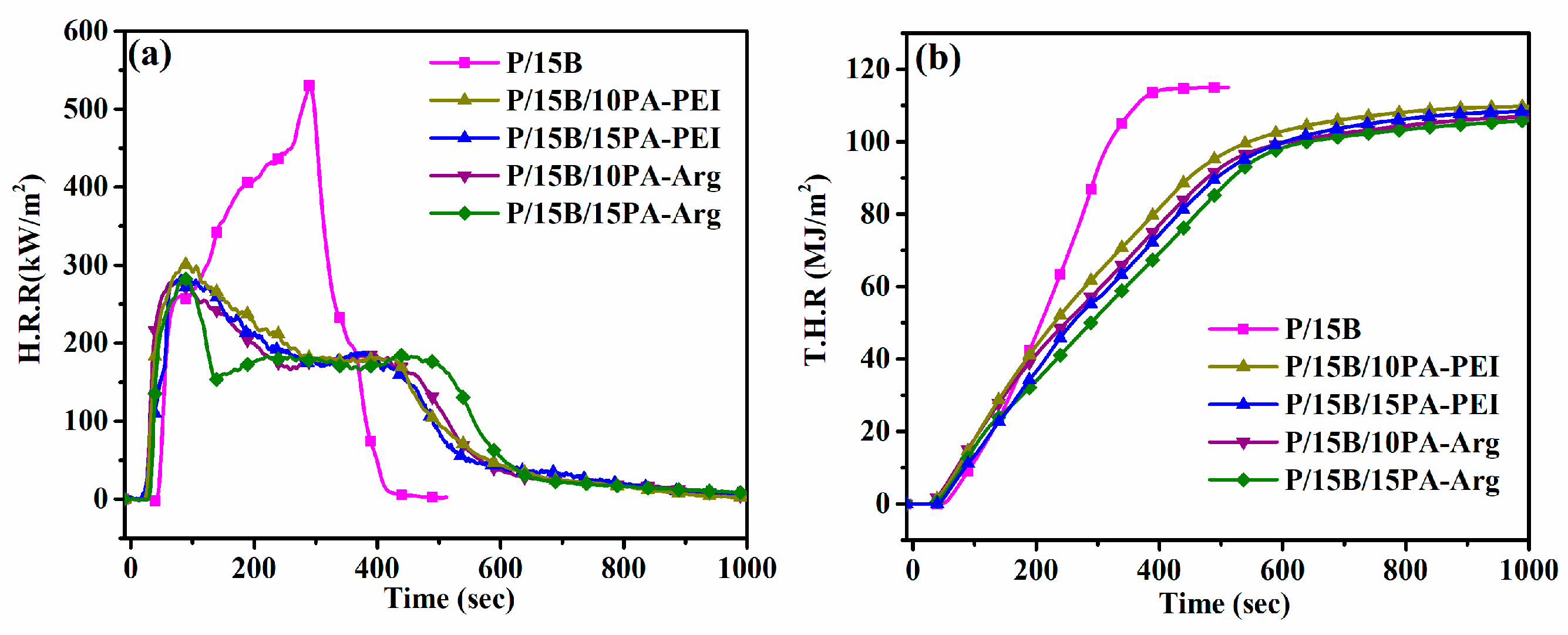
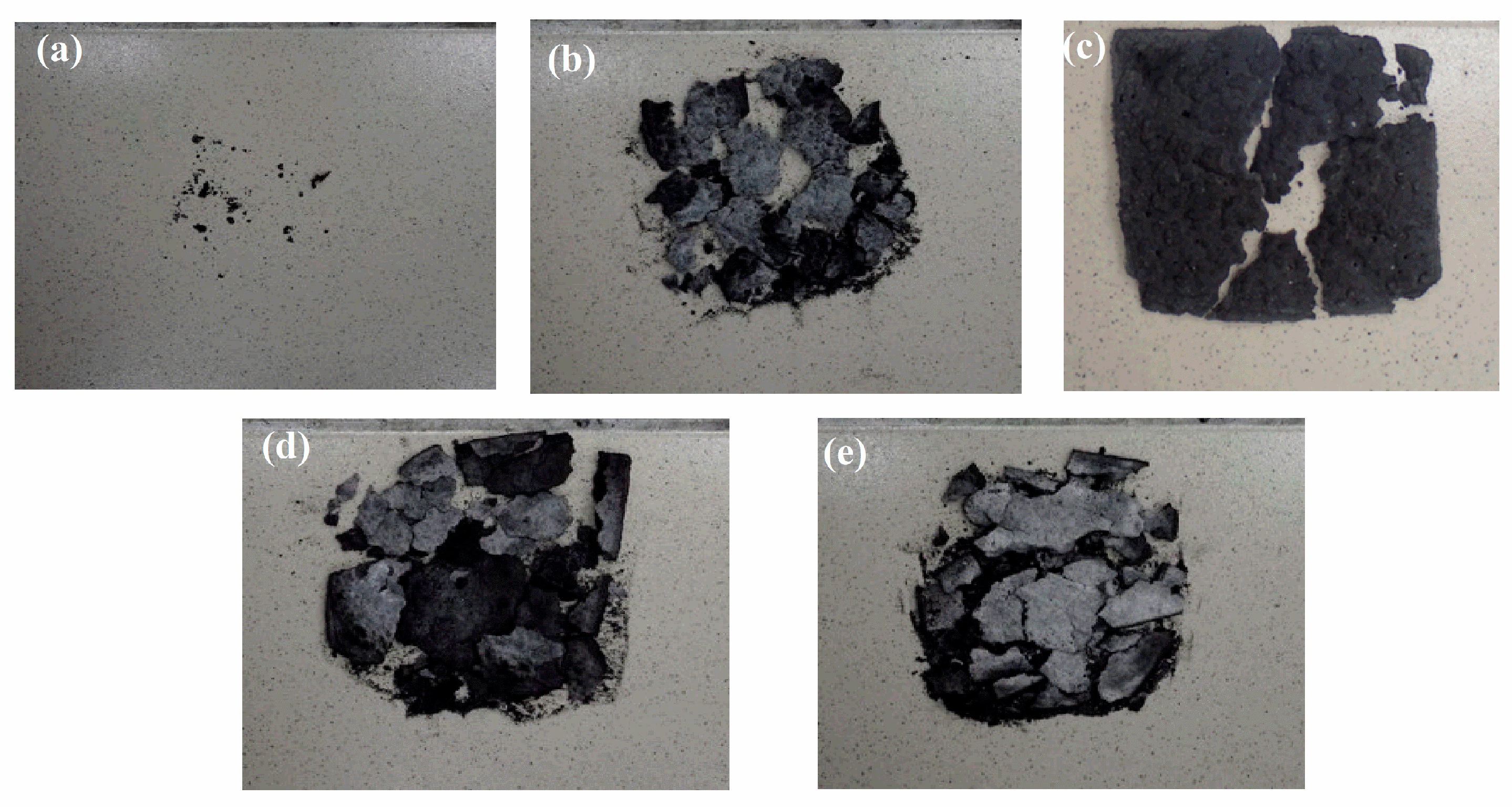
| Sample | PLA (%) | PBS (%) | PA-PEI wt% | PA-Arg wt% | SDE wt% |
|---|---|---|---|---|---|
| P/15B | 85 | 15 | - | - | - |
| P/15B/10PA-PEI | 66 | 15 | 10 | - | 9 |
| P/15B/15PA-PEI | 61 | 15 | 15 | - | 9 |
| P/15B/10PA-Arg | 66 | 15 | - | 10 | 9 |
| P/15B/15PA-Arg | 61 | 15 | - | 15 | 9 |
| Sample | T10wt%/(%/°C) a | Td1/(%/°C) b | Td2/(%/°C)c | Td3/(%/°C) d | CR550°C/(%) e |
|---|---|---|---|---|---|
| PEI | 302.97 | 359.89 | 394.40 | NA | 0.00 |
| PA-PEI | 128.51 | 319.20 | 397.57 | 440.50 | 31.58 |
| Arg | 241.16 | 244.60 | 363.32 | NA | 15.61 |
| PA-Arg | 172.73 | 243.13 | 267.71 | 319.07 | 37.15 |
| Sample | T10wt%/(%/°C) a | Td1/(%/°C) b | CR550 °C/(%) c |
|---|---|---|---|
| P/15B | 336 | 360 | 4.24 |
| P/15B/10PA-PEI | 302 | 347 | 12.17 |
| P/15B/15PA-PEI | 287 | 330 | 18.61 |
| P/15B/10PA-Arg | 317 | 351 | 13.81 |
| P/15B/15PA-Arg | 309 | 338 | 20.82 |
| Sample | Tensile Strength (MPa) | Elongation (%) | Impact Strength (J/m) |
|---|---|---|---|
| P/15B | 44.32 ± 2.98 | 2.36 ± 0.33 | 26.36 ± 2.07 |
| P/15B/10PA-PEI | 25.34 ± 0.67 | 0.35 ± 0.12 | 16.47 ± 2.40 |
| P/15B/15PA-PEI | 10.31 ± 0.12 | 0.13 ± 0.08 | 11.73 ± 0.45 |
| P/15B/10PA-Arg | 37.32 ± 3.01 | 1.97 ± 0.04 | 23.28 ± 3.80 |
| P/15B/15PA-Arg | 26.57 ± 0.34 | 0.95 ± 0.23 | 17.89 ± 0.34 |
| Samples | TTI a (s) | pHRR b (kW/m2) | THR c (MJ/m2) | Char Residues (%) | UL-94 |
|---|---|---|---|---|---|
| Vertical | |||||
| P/15B | 44 ± 3 | 532.35 ± 8.5 | 113.67 ± 2.3 | 0.05 | NR |
| P/15B/10PA-PEI | 28 ± 2 | 304.90 ± 7.5 | 110.16 ± 3.0 | 8.94 | V-2 |
| P/15B/15PA-PEI | 25 ± 3 | 290.13 ± 5.6 | 108.82 ± 1.5 | 9.83 | V-2 |
| P/15B/10PA-Arg | 22 ± 2 | 284.52 ± 9.1 | 108.19 ± 2.7 | 9.02 | V-2 |
| P/15B/15PA-Arg | 21 ± 2 | 280.26 ± 4.1 | 107.89 ± 2.5 | 10.40 | V-2 |
Disclaimer/Publisher’s Note: The statements, opinions and data contained in all publications are solely those of the individual author(s) and contributor(s) and not of MDPI and/or the editor(s). MDPI and/or the editor(s) disclaim responsibility for any injury to people or property resulting from any ideas, methods, instructions or products referred to in the content. |
© 2023 by the authors. Licensee MDPI, Basel, Switzerland. This article is an open access article distributed under the terms and conditions of the Creative Commons Attribution (CC BY) license (https://creativecommons.org/licenses/by/4.0/).
Share and Cite
Shih, Y.-F.; Lin, C.-W.; Cai, Y.-L.; Jahan, K.; Chen, Y.-H. Effects of Bio-Based Polyelectrolyte Complex on Thermal Stability, Flammability, and Mechanical Properties Performance Utilization in PLA/PBS Composites. Buildings 2023, 13, 154. https://doi.org/10.3390/buildings13010154
Shih Y-F, Lin C-W, Cai Y-L, Jahan K, Chen Y-H. Effects of Bio-Based Polyelectrolyte Complex on Thermal Stability, Flammability, and Mechanical Properties Performance Utilization in PLA/PBS Composites. Buildings. 2023; 13(1):154. https://doi.org/10.3390/buildings13010154
Chicago/Turabian StyleShih, Yeng-Fong, Ching-Wei Lin, Yu-Liang Cai, Kousar Jahan, and Ying-Hsiao Chen. 2023. "Effects of Bio-Based Polyelectrolyte Complex on Thermal Stability, Flammability, and Mechanical Properties Performance Utilization in PLA/PBS Composites" Buildings 13, no. 1: 154. https://doi.org/10.3390/buildings13010154
APA StyleShih, Y.-F., Lin, C.-W., Cai, Y.-L., Jahan, K., & Chen, Y.-H. (2023). Effects of Bio-Based Polyelectrolyte Complex on Thermal Stability, Flammability, and Mechanical Properties Performance Utilization in PLA/PBS Composites. Buildings, 13(1), 154. https://doi.org/10.3390/buildings13010154







